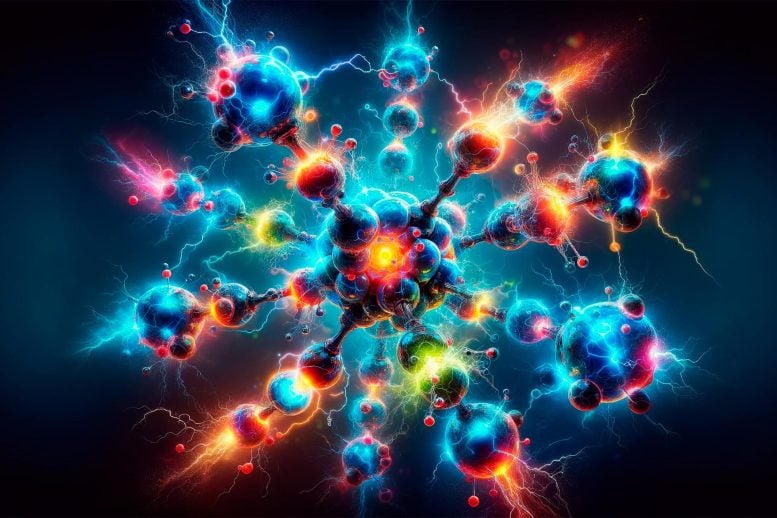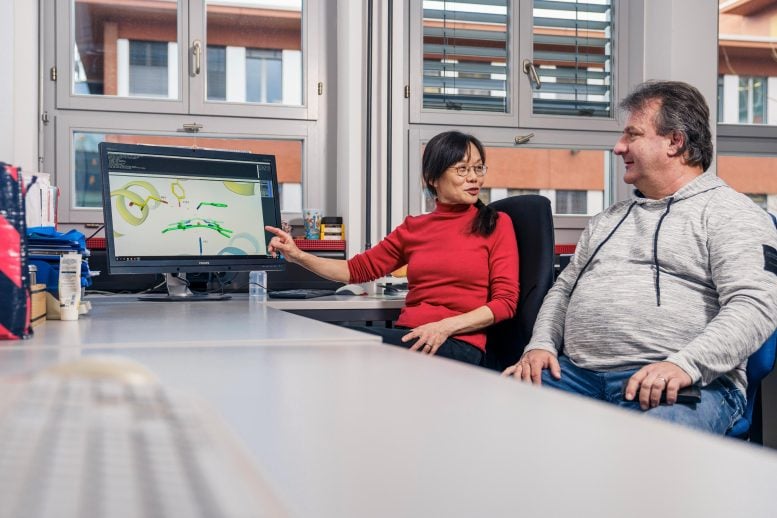
Researchers have detailed the structure and function of the enzyme styrene oxide isomerase, a tool that enables green chemistry by facilitating the biological equivalent of the Meinwald reaction. This enzyme’s ability to produce specific products with high efficiency and stereospecificity holds significant potential for the chemical and pharmaceutical industries, promising more sustainable and environmentally friendly processes. (Artist’s concept.) Credit: SciTechDaily.com
For the first time, scientists have precisely characterized the enzyme styrene oxide isomerase, which can be used to produce valuable chemicals and drug precursors in an environmentally friendly manner. The study appears today in the journal Nature Chemistry.
Enzymes are powerful biomolecules that can be used to produce many substances at ambient conditions. They enable “green” chemistry, which reduces environmental pollution resulting from processes used in synthetic chemistry. One such tool from nature has now been characterized in detail by researchers at the Paul Scherrer Institute (PSI): the enzyme styrene oxide isomerase. It is the biological version of the Meinwald reaction, an important chemical reaction in organic chemistry.
“The enzyme, discovered decades ago, is made by bacteria,” says Richard Kammerer of PSI’s Biomolecular Research Laboratory. His colleague Xiaodan Li adds: “But because the way it functions was not known, its practical application has been limited up to now.” The two researchers and their team have elucidated the structure of the enzyme as well as the way it works.
Simple Mechanism for a Complicated Reaction
Microorganisms possess specific enzymes with which they can, for example, break down harmful substances and use them as nutrients. Styrene oxide isomerase is one of these. Together with two other enzymes, it enables certain environmental bacteria to grow on the hydrocarbon styrene.
The styrene oxide isomerase catalyzes a very specific step in the reaction: it splits a three-membered ring in the styrene oxide consisting of one oxygen and two carbon atoms, a so-called epoxide. Thereby the enzyme is highly specific and creates only one product. It is also capable of converting a number of additional substances, producing important precursors for medical applications.

Xiaodan Li and Richard Kammerer have characterized an enzyme for the first time that could become an important tool for the circular economy. The monitor shows a schematic representation of the key part of the active center of this enzyme. Credit: Paul Scherrer Institute/Markus Fischer
One particular advantage has to do with the fact that in many chemical reactions, both an image and a mirror image of a chemical compound are formed, which may have completely different biological effects. But this enzyme specifically creates only one of the two products. In chemistry this property is called stereospecificity – it is particularly important for the generation of precursor molecules for drugs. “The enzyme is an impressive example of how nature makes chemical reactions possible in a simple and ingenious way,” Xiaodan Li says.
Extremely Useful in Chemical and Pharmaceutical Industries
In the course of their investigations, which they conducted in part at the Swiss Light Source SLS, the PSI researchers discovered the enzyme’s secret: an iron-containing group in its interior, similar to the iron-containing pigment in our red blood cells. This haem group binds the epoxide ring, and that’s how it makes the reaction so simple and efficient. Other parts of the investigations were carried out by the group of Volodymyr Korkhov, also from the PSI Laboratory for Biomolecular Research and Associate Professor in the Department of Biology at ETH Zurich, using cryo-electron microscopy.
Xiaodan Li and Richard Kammerer feel certain that the enzyme will prove extremely useful in the chemical and pharmaceutical industries. “It is so far the only bacterial enzyme known to catalyze the Meinwald reaction,” Richard Kammerer emphasizes. With the enzyme’s help, industry could produce precursors for drugs and important chemicals under energy-saving and environmentally friendly conditions.
Xiaodan Li adds: “The enzyme could potentially be altered so that it can produce a great many new substances.” In addition, the enzyme is very stable and thus is suitable for large-scale industrial applications. “It will certainly become a new, important tool for the circular economy and green chemistry,” the PSI researchers are convinced.
Reference: “Structural basis of the Meinwald rearrangement catalysed by styrene oxide isomerase” by Basavraj Khanppnavar, Joel P. S. Choo, Peter-Leon Hagedoorn, Grigory Smolentsev, Saša Štefanić, Selvapravin Kumaran, Dirk Tischler, Fritz K. Winkler, Volodymyr M. Korkhov, Zhi Li, Richard A. Kammerer and Xiaodan Li, 14 May 2024, Nature Chemistry.
DOI: 10.1038/s41557-024-01523-y









Thank you so much scitech for sharing this kind of information which is very informative.Again Than you.